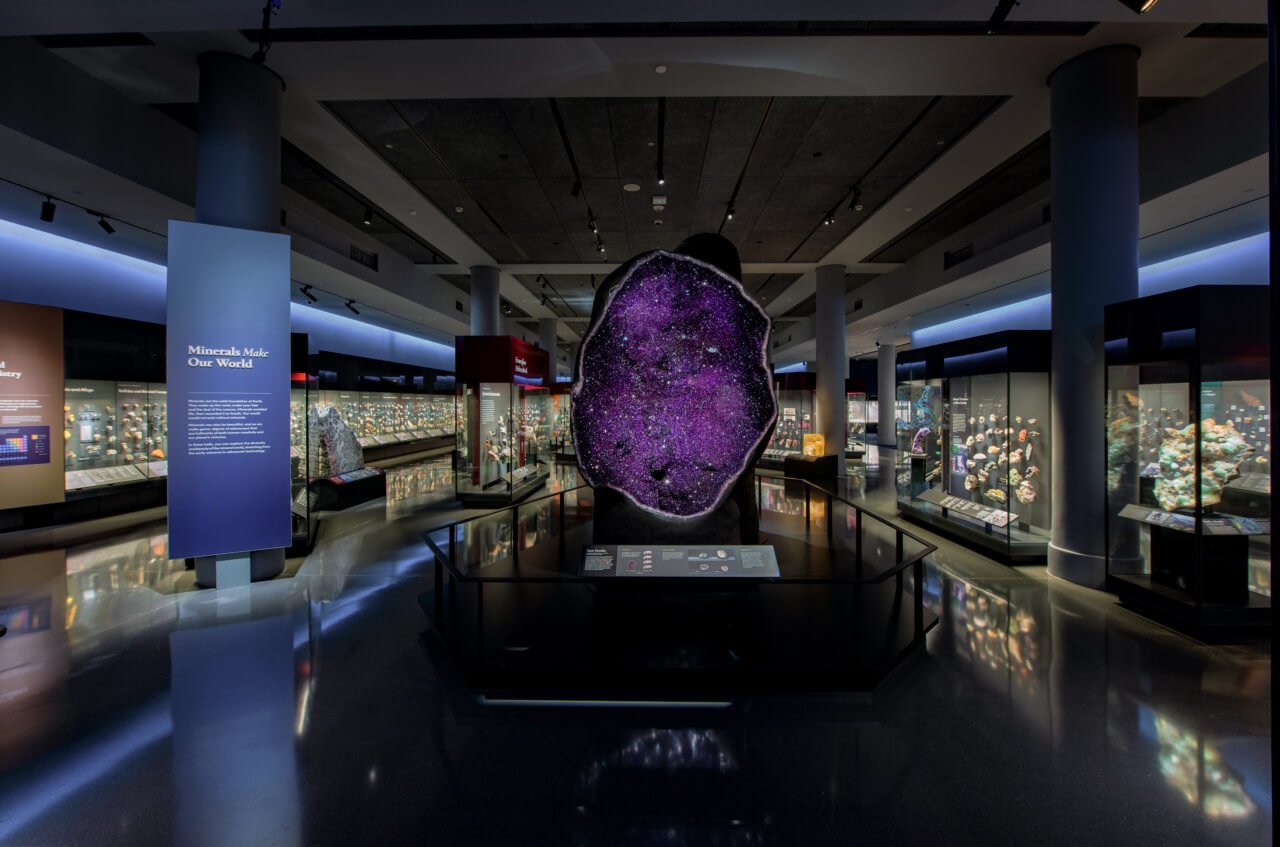Those who have been clamoring to get up close and personal with gargantuan geodes, ancient blocks of granite, and glistening hunks of yellow fluorite, your time has finally come: Originally planned to open last year but delayed by the coronavirus pandemic, the newly redesigned and reinstalled Allison and Roberto Mignone Halls of Gems and Minerals at the American Museum of Natural History (AMNH) in New York City will make their public debut on Saturday, June 12.

Designed by Ralph Appelbaum Associates in collaboration with the AMNH’s exhibition department headed by Lauri Halderman, vice president for exhibition, the newly reimagined 11,000-square-foot space is divided into three main sections where 5,000 dazzling specimens sourced from nearly 100 countries are on display. That includes the Minerals Hall, the Gems Hall, and the Melisa and Keith Meister Gallery, which is the first-ever dedicated space for rotating exhibitions located within a permanent hall at the storied Upper West Side Institution.
The inaugural exhibition within the new gallery space is Beautiful Creatures, a glittering showcase of zoological-themed jewelry created over the past 150 years by celebrated designers and artists including Cartier, Bulgari, Van Cleef & Arpels, and Salvador Dalí, whose starfish brooch is among the 100-plus pieces on display. Divided into three categories—Creatures of Land, Creatures of Air, and Creatures of Sea—the bejeweled menagerie, which was curated by jewelry historian Marion Fasel, is on view through September 19, 2021.
Outside of tarantula brooches and crocodile necklaces, the main halls are home to a dizzying number of rare—and sometimes massive in scale—geological specimens, some of them on display for the first time. They include the Singing Stone, an enormous block of blue azurite and green malachite sourced from Arizona that was first exhibited at the 1893 World’s Columbian Exposition in Chicago; a New York State-sourced slab of amphibolite rock with almandine garnet crystals that was formed more than a billion years ago; a 1.8-billion-year-old assemblage of dravite tourmaline crystals, which was formed in present-day Western Australia in metamorphic rock over 1.8 billion years ago, making it one of the oldest specimens on display; the 9-pound almandine Subway Garnet discovered under Manhattan’s 35th Street in 1885, and a wall-sized panel of glowing fluorescent rock from Sterling Hill, New Jersey.
“When I started at the Museum, there were probably 2,000 minerals described—and now there are more than 5,500 minerals,” said George E. Harlow, curator of the museum’s Division of Physical Sciences, in a statement. “The enhanced Halls will present up-to-date science, which has progressed significantly. I look forward to seeing visitors delight in remarkable gems and mineral specimens from across the globe and our own backyard, like those in the Minerals of New York display featuring specimens from all five boroughs.”
Highlights specific to the roughly 2,500-object Gem Hall include the Star of India sapphire, the Patricia Emerald, the DeLong Star Ruby, and the Brazilian Princess topaz, a 221-facet, 9.5-pound pale-blue topaz once known as the largest cut gem in the world. The specimens on display in the adjacent Mineral Hall are divided into four core sections: Mineral Forming Environments, Minerals Fundamentals, Systemic Classification, and Minerals & Light, which, per the museum, “explores the optical properties of minerals.” In addition to the crowd-drawing specimens themselves, the new Halls feature a range of dynamic educational elements including an interactive digital period table that illustrates how different chemical elements come together to “make minerals.”
Eventually, the Mignone Halls of Gems and Minerals will link to the 230,000-square-foot Richard Gilder Center for Science, Education, and Innovation. When completed, the blockbuster new facility designed by Studio Gang will link the ten buildings that comprise the AMNH campus, including the Mignone Halls of Gems and Minerals, which, prior to the redesign, had long been severed from the rest of the complex and accessible only through its south end. Following some shuffling around in the late 19th century and the early 20th century, the museum’s gem and minerals collections were housed in the Harry Frank Guggenheim Hall of Mineral and the Morgan Memorial Hall of Gems beginning in 1976.
The refreshed and renamed Halls are titled in honor of longtime AMNH benefactors and volunteers Roberto and Allison Mignone. Roberto Mignone serves as a museum trustee and Allison Mignone, who equates entering the revamped halls to walking into “the world’s jewelry box,” is vice-chair of the museum’s campaign.
“These Halls, and others in the Museum, take science off the page of textbooks and into the real-life experience of countless families and students,” said Allison Mignone in a statement. “Now more than ever, equal access to education is paramount. We look forward to the time when large numbers of students and school groups and their teachers can visit.”
That time will hopefully come sooner than later. The AMNH, like countless other invaluable institutions across the United States and abroad, is currently operating at a reduced capacity and has put a temporary pause on most non-virtual special programming, large in-person field trips, and hands-on spaces like its dedicated public educational laboratories. The lower level of the Milstein Hall of Ocean Life is also temporarily closed as it is being used as a rather spectacularly sited COVID-19 vaccination hub. Visitors holding timed-entry tickets to the museum must join a virtual queue if they wish to visit the Mignone Halls of Gems and Minerals.
“New Yorkers and visitors have long embraced these Halls as one of the City’s treasures,” said Ellen V. Futter, president of the American Museum of Natural History, in a statement. “Now, with this complete redesign made possible by Allison and Roberto Mignone, the Halls are more spectacular than ever and an even greater resource for learning about the processes that shape our changing planet and make it so endlessly fascinating. With their reopening, we not only mark a signal moment in the resurgence of New York City and the renewal of its cultural life, but also, we hope, accelerate its pace.”